Common Name(s): Bubinga, kevazingo, African rosewood
Scientific Name: Guibourtia spp., the three principal species are G. demeusei, G. pellegriniana, and G. tessmannii
Distribution: Equatorial Africa
Tree Size: 130-150 ft (40-45 m) tall,
3-6 ft (1-2 m) trunk diameter
Average Dried Weight: 56 lbs/ft3 (890 kg/m3)
Specific Gravity (Basic, 12% MC): 0.72, 0.89
Janka Hardness: 2,410 lbf (10,720 N)
Modulus of Rupture: 24,410 lbf/in2 (168.3 MPa)
Elastic Modulus: 2,670,000 lbf/in2 (18.41 GPa)
Crushing Strength: 10,990 lbf/in2 (75.8 MPa)
Shrinkage: Radial: 6.0%, Tangential: 8.2%,
Volumetric: 13.9%, T/R Ratio: 1.4
Color/Appearance: Heartwood ranges from a pinkish red to a darker reddish brown with darker purple or black streaks. Sapwood is a pale straw color and is clearly demarcated from the heartwood. Bubinga is very frequently seen with a variety of figure, including pommele, flamed, waterfall, quilted, mottled, etc.
Grain/Texture: Grain is straight to interlocked. Has a uniform fine to medium texture and moderate natural luster.
Rot Resistance: Ranges from moderately durable to very durable depending upon the the species. Bubinga is also reported to be resistant to termite and marine borer attack.
Workability: Easy to work overall, though depending upon the species bubinga can have silica present, which can prematurely dull cutting edges. Also, on pieces with figured or interlocking grain, tearout can occur during planing or other machining operations. Gluing can occasionally be problematic due to bubinga’s high density and natural oils. Turns and finishes well.
Odor: Bubinga is reported to have an unpleasant scent when the lumber is still wet, which disappears after the wood is dry.
Allergies/Toxicity: Although severe reactions are quite uncommon, bubinga has been reported to cause skin irritation and/or skin lesions in some individuals. See the articles Wood Allergies and Toxicity and Wood Dust Safety for more information.
Pricing/Availability: Despite being an endangered species, bubinga continues to have decent availability in North America. Prices for unfigured wood are in the mid range for an imported hardwood. Figured grain patterns such as waterfall, pommele, etc. are much more expensive.
Sustainability: The three Guibourtia species yielding bubinga are listed on CITES appendix II—which also includes finished products made of the wood (though non-commercial finished items under 10 kilograms are exempted). Additionally, of the three bubinga species, two of them (G. pellegriniana and G. tessmannii) are on the IUCN Red List as endangered, while the third, G. demeusei, is listed as near threatened.
Common Uses: Veneer, inlays, fine furniture, cabinetry, turnings, and other specialty items. Since bubinga trees can grow so large, natural-edge slabs of the wood have also been used in tabletops and other specialized projects.
Comments: An immensely popular imported African hardwood, bubinga may be loved as much for its quirky name as it is for its strength and beauty. The wood is sometimes called kevazingo, a name usually applied to its decorative rotary-cut veneer. In addition to its myriad grain patterns, its strength-to-weight ratio (specifically its MOR) also ranks among the very best in the world.
Bubinga has a close resemblance to rosewood, and is sometimes called African rosewood—though this name is more commonly applied to another Guibourtia species, Guibourtia coleosperma. However, its similarity to true rosewoods has been a double-edged sword, as the wood has been heavily exploited in recent years in the Chinese hongmu (rosewood) market—resulting in a ban not only on true rosewoods, but also bubinga as well.
Images: Drag the slider up/down to toggle between raw and finished wood. The first sample shows a typical quartersawn piece, while the second is a flatsawn sample, and the third is a figured piece known as waterfall bubinga.
A special thanks to Steve Earis for providing the turned photo of this wood species, as well as Chris Head for the photo of the tabletop.
Identification: See the article on Hardwood Anatomy for definitions of endgrain features.
Porosity: diffuse porous
Arrangement: solitary and radial multiples; sometimes with decreasing pore frequency in latewood
Vessels: large, very few; brownish deposits occasionally present
Parenchyma: vasicentric, lozenge, confluent, and banded (marginal)
Rays: narrow to medium width; normal spacing
Lookalikes/Substitutes: Figured pieces can sometimes be confused with sapele (Entandrophragma cylindricum) as the two can have similar pommele and rippled figuring. However, sapele has much wider and more frequent parenchyma bands (as well as a distinct cedar-like odor), while bubinga’s banding tends to be narrower, and only at growth ring margins.
Notes: Heartwood fluorescent to weakly fluorescent when viewed under blacklight, though this is variable depending on the species.
Related Content:

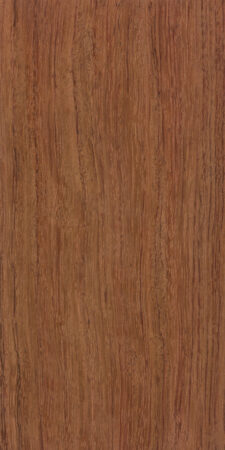
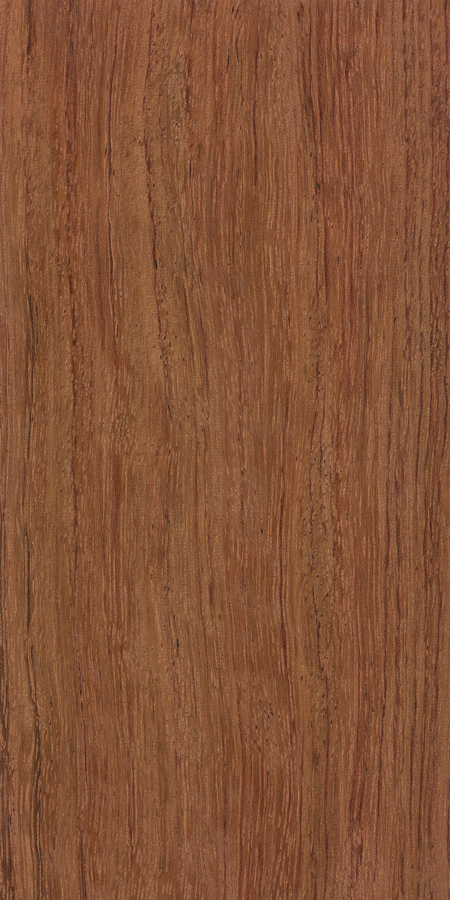
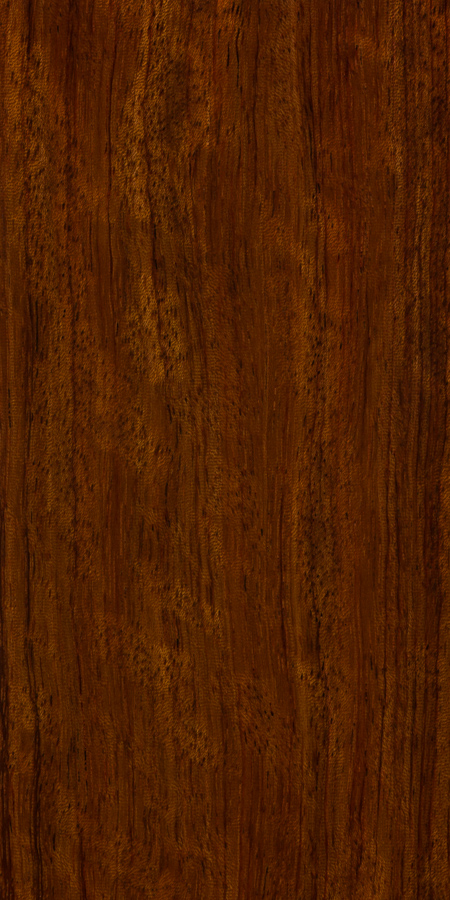
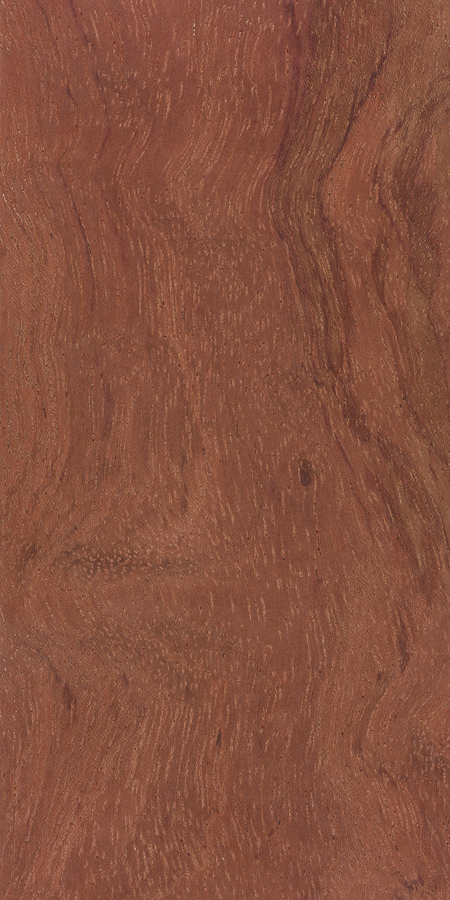
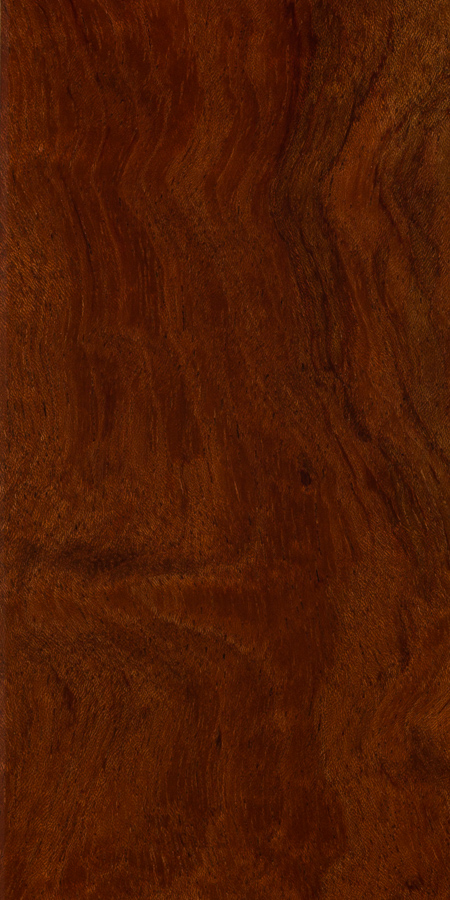
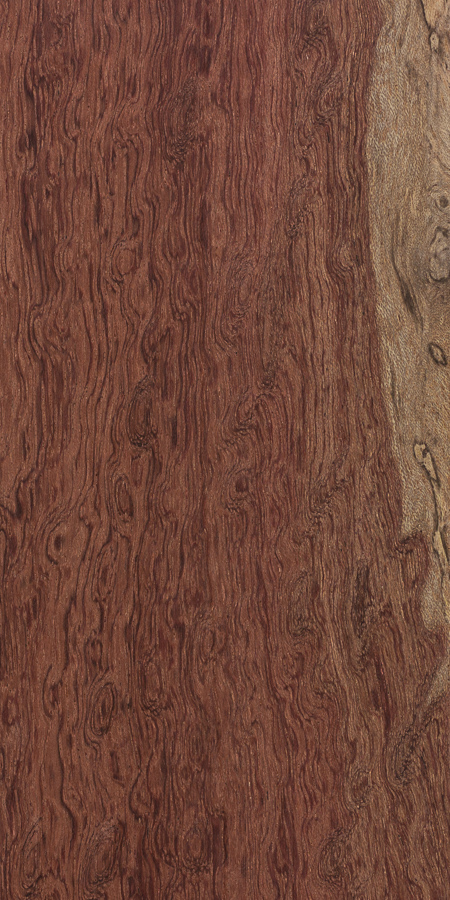
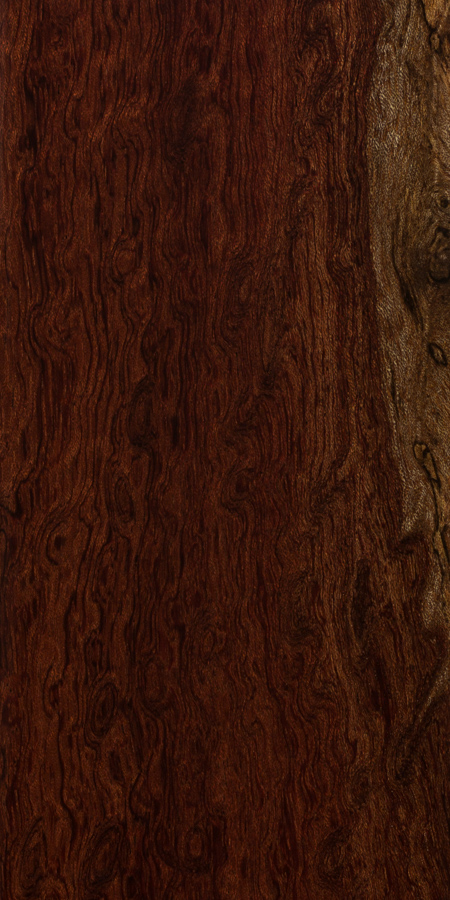
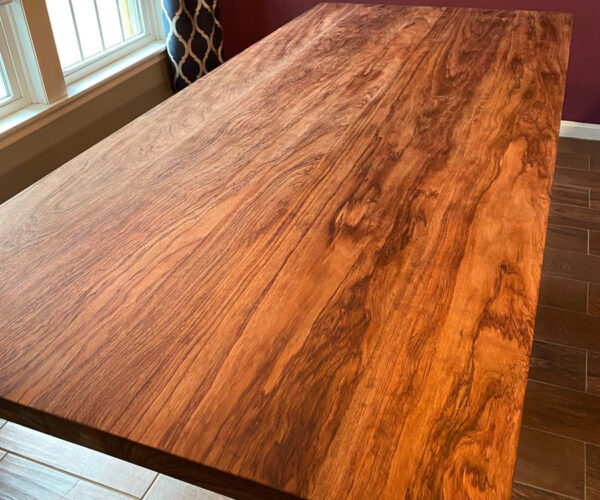
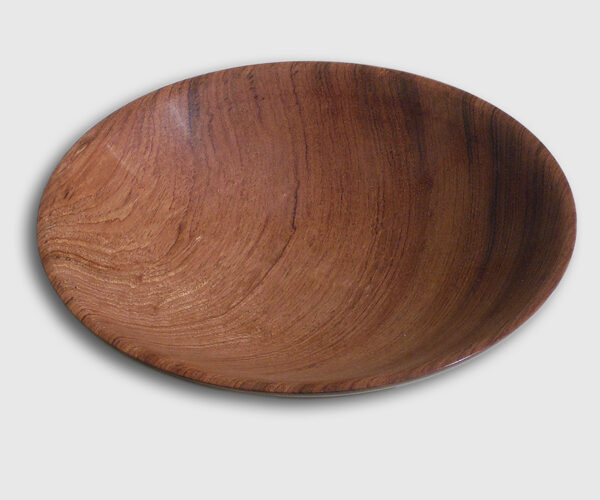
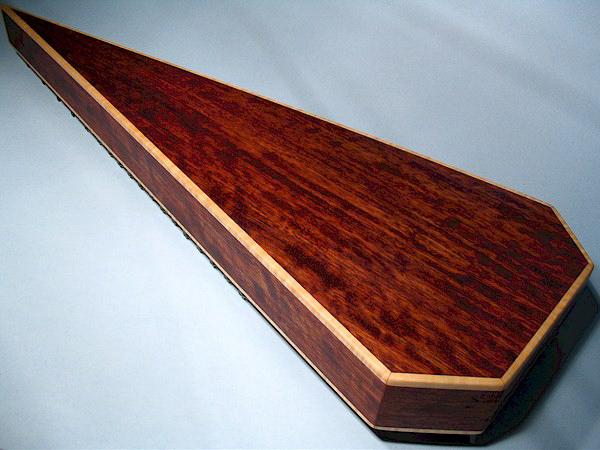
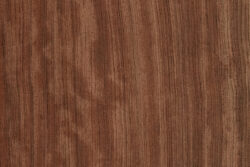
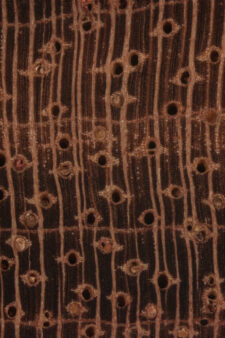

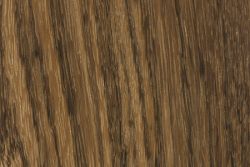
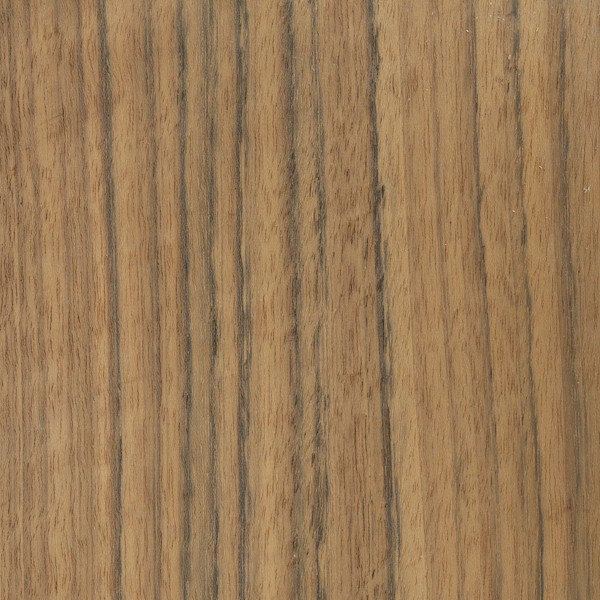
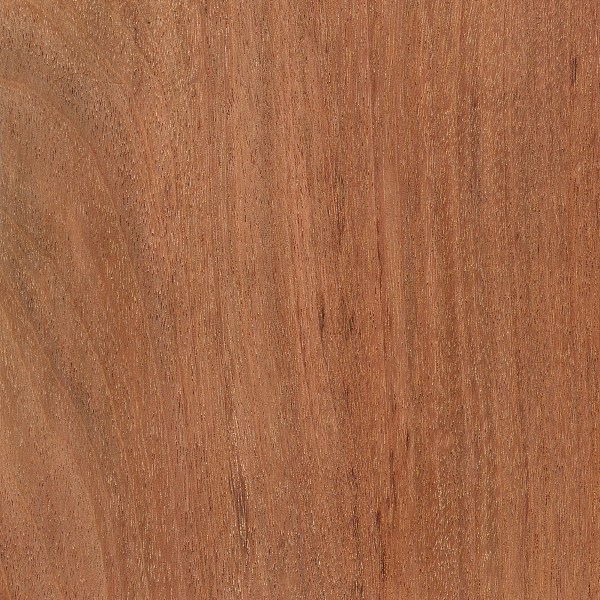
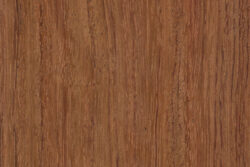
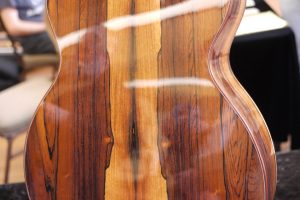
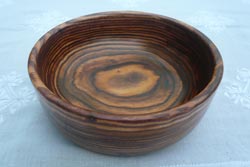
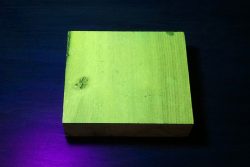
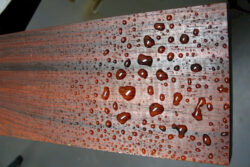

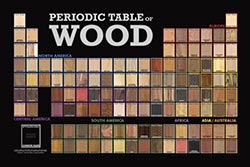





We have a beautiful mantel made of bubinga – I think it’s solid
My Dean Rhapsody 8-string bass with Bubinga top.
Waterfall bubinga table.
The glossy finish really shows off the waterfall figure well.
Thanks Eric, I’m quite obsessed with collecting exotic woods and bubinga gets close to top of my list. Here is a better view of the table.
That is freaking gorgeous, what a beautiful table! I just bought a custom-made drum set finished in waterfall Bubinga that I hope it comes out as beautifully as your table did.
Is that solid or a veneer? It’s hard to tell. But, man, it’s absolutely stunning!
Solid, 4 inch thick slab.
Solid bubinga chairs, black ones are wenge.
Made open segmented bowls out of bubinga. The tearout was minimal. Much better than cherry. Was able to sand out the problems. Used carbide tools. Sanded to 1000 grit and finished with Howards mineral oil.
Bubinga is a good choice for carving on a rotary carver. It has a nice floral smell. A hard wood with tight end grain and takes a nice polish if you take the time to hand sand the complex shapes on a carving. Like Purpleheart it burns easily if your burr is not sharp and it takes a while to sand off the discolorations if you are not careful. It does darken to a reddish brown over time. I only use lemon oil on the carvings since it looks like new every time you wipe it down. The red snapper… Read more »
Here is my Warwick Thumb with Bubinga pommele body and Ovangkol neck.
Weighing in at over 5kgs.
She sound’s beautiful, these instruments are a work of art.
Here is the second photo of the same rocker.
How beautiful! Did you make it? Your design? Do you have a pattern for it?
For better or worse, the design and construction of this rocker is all mine. I make my own patterns and I work alone. Thanks for liking it.
That is a masterpiece of art. Incredible! As much as I love different woods, my dream would be to have such a gorgeous rocker in my home. Likely the library, away from family pets and safely mine! That is just gorgeous. No other word captures it’s beauty.
Came here looking for pics./photos of wood for my new guitar and found the most outstanding pic of this exquisite rocker. Now that’s another thing I need!
That is an incredible piece of furniture. You are an artist!
Attached are two photos of one of my rockers. This one is 100% Bubinga which I bought in the rough in Long Beach, CA. I did my own milling and, indeed, there was tear-out. The rocker is stack laminated, then power sculpted, then hand sculpted and finished with 100% Tung Oil. It is now 20 years old and looks new. Bubinga is one of the harder woods to sculpt, along with Hard Rock Maple, but well worth the trouble. This rocker was three months in the making, working on and off, and rarely at an eight hour strectch. I suffered… Read more »
When held to sunlight you can see the silica crystals in it..not good to breathe
Cribbage board walnut/bulinga had silica in grain finished beautifully
I used to work with bubinga a lot. It’s sometimes very heavy and dense especially if it has any curl in it. Very strong wood, beautiful color. When it’s dry I’ve never noticed any unpleasant odor, in fact after drilling a lot of holes in it your blade will dull fairly quick and start to burn the wood, same with routing, but I did notice the smoke from some pieces when that happened smelled very sweet. Some pieces it just smelled like burned wood but every once in a while one would smell really nice. Great wood. Can be hard… Read more »
I agree with everything you have said here. I have never noticed a “bad” smell, and indeed, it is hard on tools and hard to work. BUT the finished work is very, very durable.
I found an old solid wood double bed on a rubbish pile, at first I thought it was African mahogany , after making a Sungka board out of it and further research I think it is Bubinga, any ideas would be welcomed.
Kind Regards
Greetings! Just a quick story to remind you that toxicity is a real thing. I’m a lifelong woodworker and made a recent PPE mistake; I sanded bubinga with 220 and had no respirator. A quick (small) job that by almost any comparison should have been a simple task. The next day I broke out in a severe rash where I had contact with the fine particles. Day two, my face was selling and off to the ER I went. Diagnosed as Allergic Contact Dermatitis, the cure was steroid shots, meds, and “don’t do that again”. I’m sharing this because I… Read more »
Your reaction could also be the result of exposure to DDT. Many foreign hardwoods are treated with chemicals the US no longer allows, but does allow on imported raw materials.
Definitely not DDT! Don’t just throw out random ignorance. That’s what destroyed its usefulness in the first place. Africa languishes in the deadly control of malaria because of misinformation and intentional falsification of data re DDT.
Is Bubinga recommended for end grain cutting boards, or are the pores too big?
I know it’s late, but the issue I would have with Bubinga in cutting boards is that it could blunt your kitchen knives. It’s waaay harder than the usual maple and walnut used in cutting boards.
*Sheldon voice* Bubinga!
I turned a bubinga bowl for the first time. It was very punky with some light tearout. Also tended to show tools marks that were tough to remove without making the bowl too thin. I don’t think that I will be using again for this purpose.
Had a similar experience re light tearout in making a bowl with a router bit, plus it really ate up sandpaper – not a pleasure to work with. However, the finished product is really a beauty and with a Briwax clear finish it has an understated elegance.
I made a bowl for my wife using a specialized router bit and noted the same issue with light tearout. But, after substantial sanding and a BriWax clear finish, the finished piece is has an understated elegance.
I also make my own polish using beeswax and vegetable and coconut oil, it comes out noticably nicer than the shop brought stuff and is food safe, completely natural and quite economical as I can get a bar of wax for 75p at a local honey farm and one bar can produce 2 jars of polish. I have put it on my pine shelves and oak table and alway think of what a good job it does when I see them.
I’ve got a lovely Bass made partly from Bubinga.
Love the mottled bubinga of my custom shop Warwick Thumb 5 string. But whoa is it heavy!!! Between it and the wenge neck, the tone cannot be beaten.
Beautiful guitar!
Do you have a recipie you can share for your sealant? I have a guitar with an oiled bubinga body and wenge neck. The manufacturer recommends a beeswax sealant but sometimes it’s hard to come by and is pretty expensive.
https://themoderndiylife.blogspot.com/2012/12/diy-beeswax-wood-polish-and-sealant.html
I tested his sealant for myself, and it’s become the only sealant I’ll use.
I have a 2004 Ibanez S1626FBNT, the top is a beautiful
What a beutiful guitar .
Masterful AND beautiful.
A beautiful guitar!
Goodman Drum Company African Bubinga solid wood stave snare drum!
I have a tenor recorder made by the late Albert Lockwood. It produces a clear strong sweet sound. Such a pity that there is not a great deal of solo music written for the tenor.
I have worked the wood down to 2mm thickness and it bends great for guitar sides. You can tell wood is hard. I look forward to finishing something that doesn’t have open pores.
It glues well… bends well… Nice guitar wood
I agree with you– the top is absolutely gorgeous! In fact, the entire guitar is very, very beautiful. I’ll bet it plays great!
I’m happy to read this, as I have some beautiful figured Bubinga that I plan to use for an Irish bouzouki.
I’m making a handle for a Zulu iklwa with this wood. It’s amazing to look at, hard and strong, and not too hard on the tools. One thing though, they weren’t kidding when they said the odor is “unpleasant”. That’s an understatement – it smells like vomit. Literally. It actually has that choking tang that only (or so I thought) vomit has. If you leave any shavings or dust laying around, you’ll come back the next day and think “Who threw up in my shop?” If it’s dry, I’ve been told that it doesn’t stink. Other than that, great wood!
Yet another reason to use dried wood! Reading this made me realize why I’ve seldom seen green turning blanks of Bubinga.
I’m considering using bubinga in some pieces. Has anyone tried steam bending it?
Do not assume that your wood is properly seasoned when you get it… with these denser wood it is best to sticker them until they have acclimated to your shop. I have bought wood that was “dry” from suppliers but they needed more time before they are completely dry. This is the reason why I prefer buying unprocessed lumber and surfacing it myself…
Timberline in England is where i bought mine from for making a native flute.
https://www.exotichardwoods.co.uk/
Sell all sorts of sizes & shapes
i want to buy bubinga timber but dont know if i can preferrably in Ireland or else england.
Bubinga is used a lot in native american flutes with a wonderful bright tone and gorgeous finish. For the data base – I believe this is also known as african rosewood?
I generally prefer a mellower tone for my native American flutes (mahogany sounds incredible). I wonder if it would be suitable for an Irish flute.
In my experience with bubinga, as I took my pieces down to finished size, I had some slight to moderate warping in the wood. I don’t know if humidity was a factor or not. Or maybe the wood didn’t fully dry before I bought it, but would suggest approaching the finished size gently and allowing the freshly cut wood fibers to adjust accordingly.